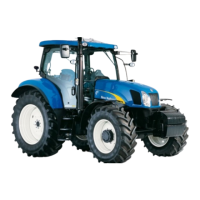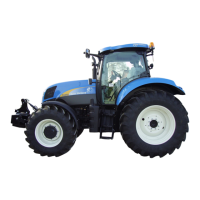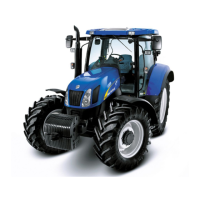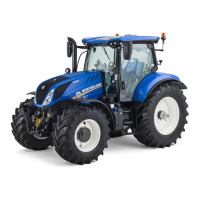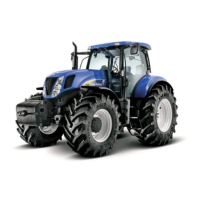SECTION 3 -- FIELD OPERATION
3--136
Too little ballast:
• Rough ride
• Excessive wheel slip
• Power loss
• T yre wear
• Excessive fuel consumption
• Lower productivity
Toomuchballast:
• Higher maintenance costs
• Increased driveline wear
• Power loss
• Increased soil compaction
• Excessive fuel consumption
• Lower productivity
For maximum performance in heavy draft conditions
weight should be added to the tractor in the form of
liquid ballast, cast iron weights or a combination of
both.
Front end ballast may be required for stability and
steering control when weight is transferred from the
front to the rear wheels as rear mounted implement
is raised by the tractor 3-point linkage.
When a rear mounted implement is raised to the
transport position, the weight on the front wheels
should be at least 20% of total tractor weight.
CAUTION
Additional front ballast may be needed when
transporting large 3-point mounted equipment.
Always drive slowly over rough terrain, no matter
how much front ballast is used.
For optimum performance and efficiency, two wheel
drive tractors should be ballasted so that
approximately one third of the total tractor weight
(less implement) is on the front wheels. Four wheel
drive tractors should be ballasted so the weight on
the front wheels is approximately 40 -- 45% of the
total tractor weight.
Add additional front end ballast, as required, for
stability during operation and transport. Ballasting of
the front end may not always provide adequate
stability if the tractor is operated at high speed on
rough terrain. Reduce tractor speed and exercise
caution under these conditions.
When using front mounted implements it may be
necessary to add weight to the rear wheels to
maintain traction and stability.
BALLASTING WITH FRONT AXLE
SUSPENSION
IMPORTANT: On tractors fitted with front axle
suspension, correct ballasting is essential to
optimise suspension operation, particularly when
using heavy rear mounted equipment. For this
application, sufficient front ballast must be added by
the use of wafer weights in preference to liquid
ballast in the tyres
In certain conditions, with insufficient front weight
added, suspension operation may become disabled
and error code 10007 displayed. Stop the tractor,
switch off the engine and restart again to clear the
error code and re--enable the suspension. If the error
code re--occurs, then further front weight should be
added ensuring maximum axle and vehicle weights
are not exceeded.
Ballast Limitations
Ballast should be limited by the tyre capacity or
tractor capacity. Each tyre has a recommended
carrying capacity which should not be exceeded,
(see pages 3--144 and 3--145 ).
If a greater amount of weight is needed for traction,
larger tyres should be used.
Ballast can be added by bolting on cast iron weights
or by adding liquid calcium chloride in the tyres.
Bolt-on cast iron weights are recommended because
they can easily be removed when not needed.
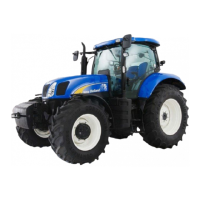
